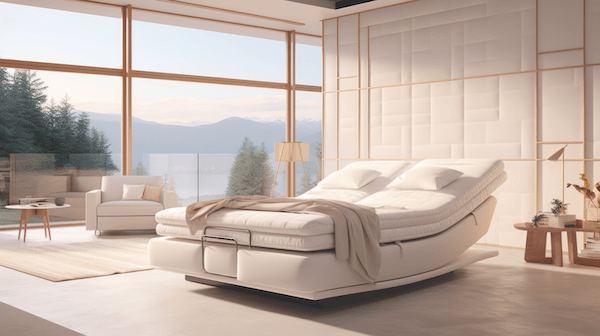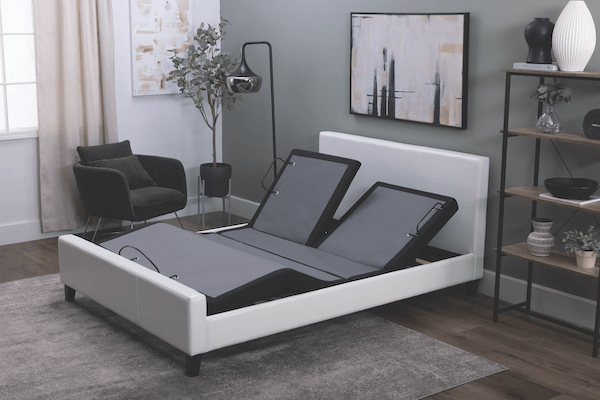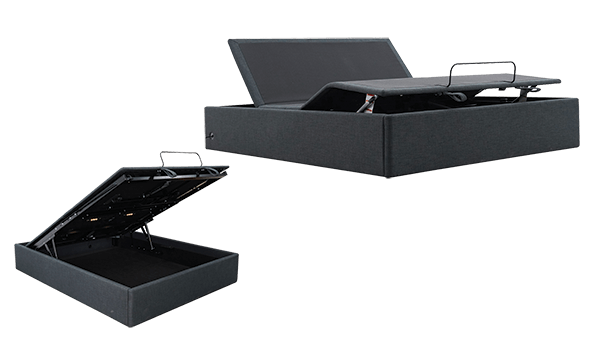Makers of power foundations continue to add consumer-enticing features, like smart connectivity and split heads, to build interest in the category.

When it comes to buying adjustable bases, today’s consumers seek a good value and want practical features that will enhance their sleep and lives, makers of the products say.
And manufacturers of adjustable bases are meeting consumers’ needs with well-priced models, as well as split-head designs, smart remotes and other features.
After strong growth in the category in recent years, producers say the market is maturing but that there is still room for growth as they win over consumers with new designs and more retailers make touting power bases a routine part of the mattress sales process.
“I do not think we have seen the height of the market, but I do feel that we are not going to see the explosive growth in this category we have seen over the past several years,” says Brent Polunsky, sales manager for W. Silver Products, a maker of adjustable bases and other bed frame products based in El Paso, Texas. “There is a big difference in the attachment rate from dealer to dealer. I see the growth in helping the dealers who have not totally embraced this category and training their staff on how to sell adjustable beds. The consumers will still purchase an adjustable base if we present the right story at the right time of the selling process.”
John Zanatta, director of sales for Leggett & Platt Adjustable Beds, a division of Carthage, Missouri-based Leggett & Platt Inc., says the power base market has been experiencing the same challenges that have recently dampened sales across the entire bedding industry and that, in general, the adjustable market is cyclical. For instance, innovations like L&P’s WallHugger technology in the late 1990s helped spark a round of strong sales, he says.
“Then we saw it again when manufacturers started reducing the weight and folding their bases to make them easier to handle while keeping a majority of the features present. We saw it again with the focus on the head-only base that introduced adjustable bases to a new group of consumers,” Zanatta says. “We’re all out looking for that next ‘must-have’ feature, which captures the interest of the consumer.”
Something for everyone

thanks in part to lower price points but also because they offer many of the same advantages of “a traditional split king/queen setup,” says Leggett & Platt Adjustable Beds’ John Zanatta.
The range of power bases available to entice consumers is broad, from entry-level, head-only adjustables that some retailers still use as a “free with purchase” deal to high-end smart bases like Ergomotion’s Dawn House and Ergo-Sportive brands. Those beds illustrate the equally broad range of consumers who can benefit from a power base.
Ergomotion, an adjustable base specialist with offices in Santa Barbara, California, describes its award-winning Dawn House bed as “the ultimate hospital bed alternative,” designing it to improve sleep and allow people to live independently. The base has adjustable height and other accessibility features, plus white-glove delivery and installation. With a mattress, it retails for $5,998.
Targeting a different group of consumers — those with active lifestyles — Ergomotion’s ErgoSportive is an adjustable bed with built-in health sensors and an integrated app focused on health, fitness and recovery. Paired with a hybrid mattress, it retails for $5,298.
The sweet spot
Entry-level adjustable bases introduce many consumers to the category. And top-of-the-line bases draw plenty of media attention, satisfy key consumers’ needs and help advance the category as their novel features later work their way into beds with lower price points. But the majority of power base sales remain in the midrange of pricing, manufacturers note.
“High-end features will always draw the most attention, but when you really look at what consumers are bringing into their homes, you’ll see that it’s the current version of the traditional adjustable bases that have been selling best for years,” Zanatta says.
“Head and foot articulation paired with a variety of convenience and comfort features (memory, USB charging, underbed lighting and massage) continues to be the ‘meat and potatoes’ of our segment,” Zanatta continues. “It’s fantastic that more consumers than ever have been introduced to adjustable bases through the head-only base at the entry level of the market, but those consumers quickly realize that they want additional features.”

storage, making it ideal for small homes and bedrooms that need extra space for clothing, linen or other items.
Kyle Burns, director of marketing for Ergomotion, agrees, noting that two of the company’s most popular power bases are the Rio 3.0 and Rio 4.0, which start at about $700 retail for the base only. “Both beds offer the consumer flexibility with a zero-clearance design and adjustable height legs,” Burns says. “They both also offer wireless remotes with a host of one-touch features, such as Zero-G, one-touch flat and programmable presets. Both beds also feature underbed lighting and full head and foot articulation. The Rio 4.0 goes further by offering massage with three intensities, as well as USB ports under both sides of the bed.”
W. Silver is playing in that midrange pricing with its latest introduction. At the recent Las Vegas Market, the company debuted an adjustable base retail priced at $995 in queen size for the base only. A key selling feature is its lumbar support, Polunsky says.
At the lower end of the market, Polunsky worries about declining quality that sometimes coincides with declining prices.
“The biggest challenge we have in our industry is the race to the bottom,” he says. “We are not taking care of the consumer by lowering the quality of the product. … The consumer expects to purchase a product that will last. … We will have a disgruntled consumer that might not repurchase an adjustable bed if we, as an industry, manufacture a base that will not last.”
Burns agrees about the importance of continuing to offer high-quality products at all price points.
“Our team takes great pride in the design, materials and craftsmanship that goes into our products,” he says. “This results in a stable adjustable base with silent drive motors that won’t disrupt sleep and features that will continue to work for the life of the bed.”
On trend
Focusing on product quality and life-enhancing features can satisfy consumers. And when it comes to specific features, producers point to some key trends:
Plays well with others
Zanatta says many of today’s consumers prefer bases that work with their existing furniture or that complement the new bedroom furniture they are purchasing at the same time as their new mattress and base set. “Consumers spend a lot of money on their furniture and they don’t want to make the decision to exclude an adjustable base because it won’t work with their underbed storage,” he says. Those desires make slim, lighter bases that can “rest on platforms, slats or the traditional legs” popular, he adds.
And speaking of storage
At the recent Las Vegas Market, Ergomotion debuted Stow, an adjustable base designed for smaller homes and bedrooms that opens the foot to allow access to 19 cubic feet of lighted storage. “The Stow is easy to operate and offers ample space to store extra bedding, clothing, decor and other items,” Burns says. It will retail for $1,799 in queen size.
Splitting the difference
“One of the biggest trends we’ve seen in the past six months is the return of the split-top head on an adjustable base,” Zanatta says. “This is a feature L&P first introduced to the adjustable base back in 2000. … The split-top base provides individualized adjustment for the head of the base with a joint foot section. This gives the consumer a more cost-friendly base over a traditional split king/queen setup, all the while retaining the individualized comfort granted with a traditional split base.”
Polunsky says W. Silver’s split-head beds, along with its traditional head-tilt models, “are doing very well right now.”

during the recent Las Vegas Market.
In Las Vegas, Ergomotion debuted the Duetto, a split-head base that allows each sleeper to independently control the angle of the head portion of the bed. “No more compromising,” Burns says. “Each remote controls both sides, so you can easily adjust both sides from either remote.” Other features include the company’s Zero-G and anti-snore settings, as well as underbed lighting. The Duetto base retails for $1,099 in queen size.
Getting smarter
Base manufacturers continue to add features that connect adjustables to other electronics in the home and also upgrade remotes for easier use. “Our LP Comfort Connect technology turns one of our bases into a smart home compatible device,” Zanatta says. “We wanted to go beyond a voice-controlled remote as seems to be the norm. While our base can be controlled via voice, it is also fully compatible with Amazon’s Alexa ecosystem. It can be utilized in a routine like any other smart device. A consumer can create a routine based on a command or a specific time, but our base can also accept trigger commands from other devices, such as a door/window lock or other safety device that does not require a voice or time prompt.”
The strength of in-store sales
While advancements in packaging, no-hassle return policies and extensive advertising created a massive market for online mattress sales, some makers of adjustable bases say it’s still a category that has strongest sales in brick-and-mortar stores.
“Understanding the value of an adjustable base is still very reliant upon experiencing it in person,” Zanatta says. “This can be seen in the difference between online and in-person attachment rates. We sometimes forget that the adjustable base can cost as much or more than the mattress the consumer has chosen. Introducing the adjustable base at the start of the conversation will continue to provide successful attachments to the mattress.”
Well-educated retail sales associates are key to helping shoppers understand the true benefits of the products, Polunsky says.
“The consumer wants an adjustable bed,” he says. “We must have the right features, at the right price — and present it during the selling process. All consumers have either a health-based challenge or a recreational activity that an adjustable bed will solve. I believe the RSA just has to overcome one of these issues and present the right base, and most consumers will purchase the base.”




